Knowledge management & understanding its importance
Years ago, having greater knowledge garnered accolades. People who knew more were seen as “experts” and able to earn higher wages. Organizations that had greater knowledge were able to gain an advantage over their competition and increase profits.
In today’s hypercompetitive business landscape, organizations continue to look for every advantage they can get. Knowledge is available to everyone, everywhere, and all the time. How can a business get an advantage from knowledge then?
More and more evidence is pointing to knowledge management as a potential avenue for competitive advantage. Tools like Confluence help teams keep their knowledge secure and organized. Confluence can also help organizations serve their customers by integrating with Jira Service Management to provide a centralized place for all product support. Users can log into Confluence to find answers to questions they normally would have to pick up the phone or send an email.
Confluence makes knowledge management fairly simple. You can create pages, upload documents, and organize your content across Spaces in page trees. Blueprints and Templates within Confluence allow you to standardize your layout and approach to individual pages. And if you are using Confluence Server or Data Center, you can standardize your Spaces as well. Confluence comes with a bunch of page Templates and Blueprints out of the box. Some of the most popular Templates are Meeting Notes, Project Requirements, and Decisions. This feature is completely customizable as you can create your own Blueprints and Templates to standardize your own type of content.
But what about scaling? What happens if you have a new project and you need to create dozens of pages? What happens when you release a new product, and you need to set up a support space for that product? What if you don’t have anyone technical in your team to write the code for a Blueprint? What if you want to update content across multiple pages and Spaces? There is one answer to all of these questions; Blueprint Creator.
Scale
Say you are a project manager and you are starting a new project. You’ve done this many times before, and you know the company processes by heart. Normally, you would just create the pages one by one based on your custom Templates in Confluence. This involves a lot of clicks and can take time, depending on how many pages you have.
With Blueprint Creator, you can easily create the entire project Space with just a few clicks. It’s possible to use any predefined Space to create a series of pages to suit your organization’s processes.
If you only want a section of those pages, Blueprint Creator can also create a group from just a page tree. This allows you to scale your knowledge management system to many different categories and Spaces in Confluence with ease.
Consistency
When storing knowledge in Confluence, it’s convenient to use Page Templates and Blueprints. They allow you to bring consistency to the way your information displays to your audience. If information appears consistently on a page, it is a lot easier to find. On top of individual pages, if an entire Page Tree or Space is laid out the same way, it will be even easier to find important information.
One way Blueprint Creator brings consistency for viewers of Confluence content is by providing automatic labels and title prefixes. When the user enters Confluence to search for the pertinent content, they can search by labels or the title prefix. This is possible because when knowledge managers create the page trees or Spaces, they can automatically add the same prefix in the title and labels to similar page types.
In addition to the end-users benefit, if an entire page tree or Space looks identical to another, the pages will be much simpler to create because the knowledge managers will know exactly how to design the page tree or Space. With Blueprint Creator, this can be done with a few clicks, bringing the knowledge manager consistency in layout and design for all their knowledge categories.
To shed more light on all of these advantages, let’s use an example. Say you are a knowledge manager creating documentation for a new product called “Home Builder.” You can use the “Documentation” Blueprint Space that you created previously. This allows all of your predefined pages to have similar page titles. When you create the Space, you will fill out a form and enter your product name. This populates all of the items containing the “title prefix” macro with “Home Builder.” On top of this, you can set predefined labels for all of your pages. When you create the Space, Blueprint Creator adds all the labels automatically. An example of this could be your troubleshooting page. Blueprint Creator can automatically add the label “troubleshooting” to that page. This allows end-users to quickly find pages and knowledge managers to quickly create pages.
Usability
Out-of-the-box, Confluence provides great predefined Templates and Blueprints. If you are looking for a certain template and can’t find it, you can always create your own. For a Template, this is quite simple, but you need some coding skills, specifically Velocity and Java, for a blueprint. With Blueprint Creator, these coding skills are no longer needed.
Creating a custom Blueprint with Blueprint Creator is just as easy as creating a page with Confluence. Non-technical knowledge managers can create a stunning Blueprint for their entire team to use. Once the knowledge manager creates the Blueprint, members who use that Blueprint will need to complete a form to create information in the Blueprint placeholders. These Blueprints are not limited to pages. Knowledge managers can also create them for Page Trees and Spaces. Below is an example of the early stages of a Space Blueprint.
Overall, Blueprint Creator saves time by bringing ease of scale, consistency, and usability to the knowledge management process. The icing on the cake is that as Space administrators, we will have to spend even less time cleaning up and organizing (gardening) our spaces as they develop. When we use Blueprint Creator to create consistent Spaces and Page Trees, the ad-hoc tasks of managing those spaces decrease significantly.
Further Information
Want to learn more about the Blueprint Creator for Confluence? Are you interested in testing out the app commitment-free? You can find the Blueprint Creator on the Atlassian Marketplace. If you have further questions or would like to arrange a demo appointment, our development team would be happy to talk to you. Get in touch with us today!
The Blueprint Creator website for Confluence
Blueprint Creator: How to use blueprints for uniform blog posts in Confluence
Blueprint Creator for Confluence – blueprints for spaces now available
Templates and blueprints in Confluence
Learn more about Creative Commons licensing and //Seibert/Media







